The Allianz Arena played host to one of the most exciting matches of the European Championships thus far on Tuesday night, with Spain emerging victorious over a disappointing French side. Having reached their first major tournament final since the culmination of their ‘golden generation’ in 2012, Luis de la Fuente’s new-look Spain continues to impress in the way they attack with flair and battle adversity. It would appear that they are clearly mature beyond their years, rising to the occasion and knocking off another tournament favourite, having bested the host nation, Germany, in the quarter-finals.
When it comes to Didier Deschamps’ France team, their passive and conservative approach could only get them so far; with the French perhaps ruing the opportunity not to unleash their wealth of talent. Despite boasting significant defensive strength throughout the tournament, it was fitting that 16-year-old Lamine Yamal would be the catalyst to penetrate the French guard and throw the balance of the match in favour of the Spaniards. A disappointing end to an underwhelming campaign culminated in the French team unable to match the attacking invention of de la Fuente’s side, stunned by the manner in which they let their crucial lead slip from their grasp.
This tactical analysis will begin to delve into the key talking points from this action-packed affair, highlighting some of the key moments which allowed Spain to progress to Sunday’s final in Berlin. Our analysis will focus on the tactics of both teams, with an emphasis on de la Fuente’s ability to remain progressive and adventurous in the face of adversity.
Lineups
Spain
GK: Unai Simón, RB: Jesús Navas, RCB: Nacho, LCB: Aymeric Laporte: LB: Marc Cucurella, LCM: Rodri, RCM: Fabián Ruiz, LW: Lamine Yamal, AM: Dani Olmo, RW: Nico Williams, CF: Álvaro Morata
Heading into the semi-final, it was actually Spain who were unable to field their desired XI, thanks to both suspension and injury. Their marathon match with Germany resulted in the suspension of both Robin Le Normand and Dani Caravajal, with Pedri’s tournament abruptly ended, having been the recipient of a Toni Kroos challenge early on.
This left De la Fuente with no option but to deploy Jesus Navas as Spain’s right-back, along with Nacho returning to the lineup, partnering with Aymeric Laporte in central defence. Having produced electric performances from the substitute’s bench thus far, Dani Olmo was entrusted with a starting berth, a decision which paid dividends with his attacking versatility and ability to pull the French defenders out of their comfortable shape.
The rest of Spain’s lineup was all too recognisable for their opposition, having maintained a healthy squad with incredible cohesion and grit. As we have discussed throughout the tournament, Spain’s thrilling young wing partnership continues to terrorise opposing defenders, having an unthinkable influence upon the outcome of these huge encounters.
France
GK: Mike Maignan, RB: Jules Koundé, RCB: Dayot Upamecano, LCB: William Saliba, LB: Theo Hernández, RCM: N’Golo Kanté, CM: Aurélien Tchouaméni, LCM: Adrien Rabiot, RW: Ousmane Dembélé, LW: Kylian Mbappé, CF: Randal Kolo Muani
France, on the other hand, had arguably a more favourable position heading into this match, with Adrien Rabiot returning from suspension and rejoining their midfield trio of Tchouaméni and Kanté. The rest of France’s starting eleven remained the same, barring a switch on the right flank, with Antoine Griezmann making way for Ousmane Dembélé. Having injected life into the French attack in their victory over Portugal, it was perhaps the desire to hurt Spain on the counterattack which saw Deschamps opt for the versatile PSG winger over the more creative Griezmann. Dembélé’s raw athleticism and willingness to stretch the Spanish defence appeared as though it would be more beneficial when compared to Griezmann’s talents when it comes to picking up pockets between the lines, predominantly due to Rodri’s ability to extinguish attacks from the base of Spain’s midfield.
Mbappé unmasked
For the first time since France’s opening match with Austria, we saw a maskless Kylian Mbappé, free from the physical restraints his faceguard had provided, and perhaps gave further hope of a more complete and functional France performance. His influence was felt from the very outset, combining nicely with the flying Theo Hernández, who provided excellent supporting runs to keep the Spanish defence guessing. Mbappé’s ability to remain dangerous when holding his width was perfectly highlighted in France’s opening goal- their first from open play in Euro 2024.
France intelligently used their overloads on the right-hand side to relieve pressure on the opposite flank, allowing Mbappé to become isolated against the ageing understudy in Navas after an excellent switch from Dembélé. It was at this point that which Navas was obviously caught in two minds about whether he had the physical capabilities to remain tight to the dynamic forward or afford him more space to work the ball into the box. Despite movement to close down the French winger, it was ultimately too late, and Mbappé’s cross was headed home by Kolo Muani, taking advantage of Spain’s vertical deficiencies at the back post. Yamal had attempted to support the defensive efforts from his more advanced position, but the crucial movement of Hernández had caused the Barcelona youngster to wait that split second too long before engaging with Mbappé.
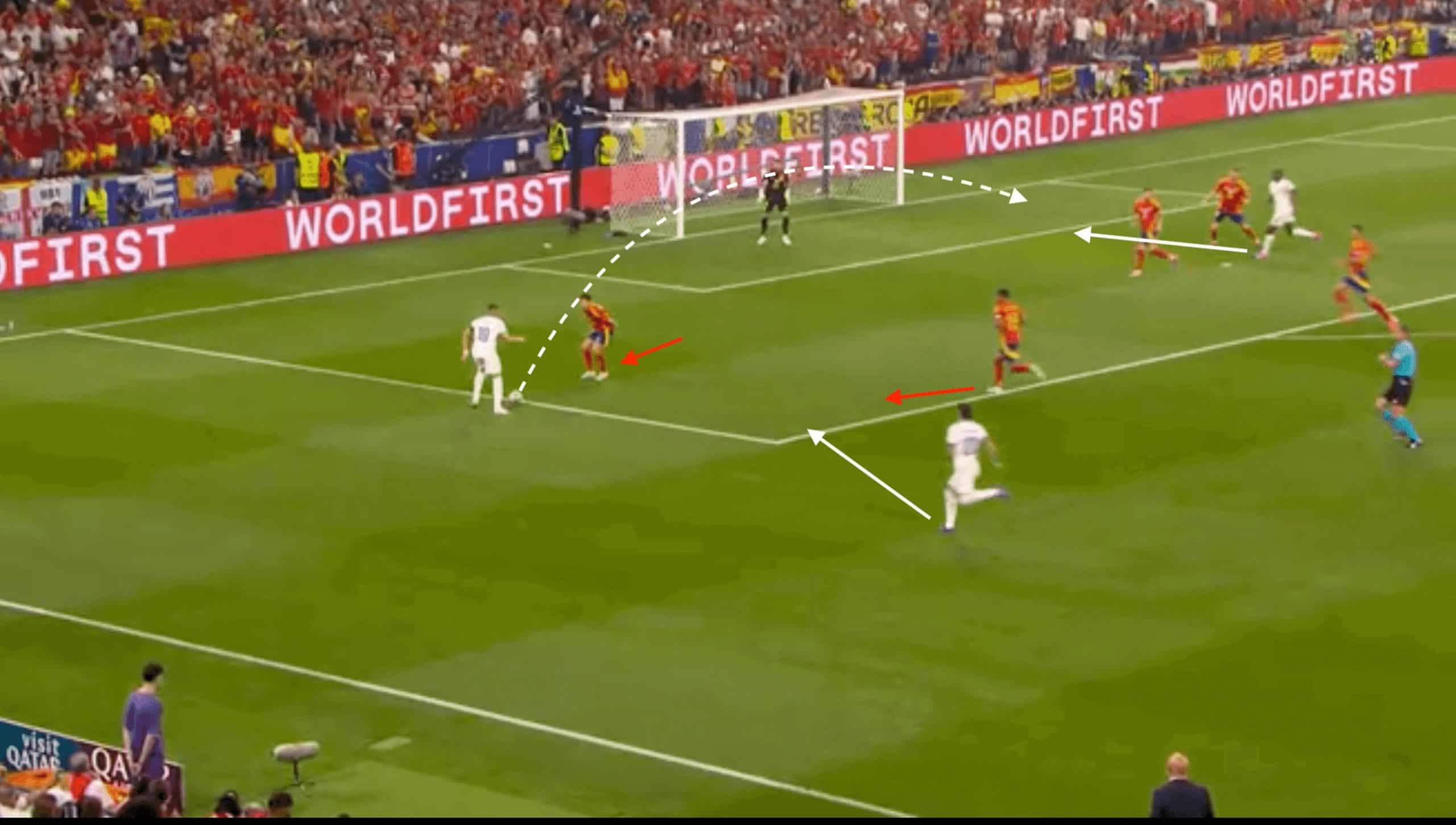
In defiance of their early defensive troubles, the Spanish response was equally as important in halting any French momentum on the left flank. After the opening goal, we saw a prime example of Spain’s unity across the pitch, with Rodri often sliding across from the double pivot to screen any lanes inside the pitch which Mbappé could continue to exploit. Nacho coming across to meet Mbappé before he could enter the penalty area allowed Spain to feel much more comfortable in defence, especially when given both Navas and Cucurella the freedom to continue their attacking threat, which would eventually decide the fixture.
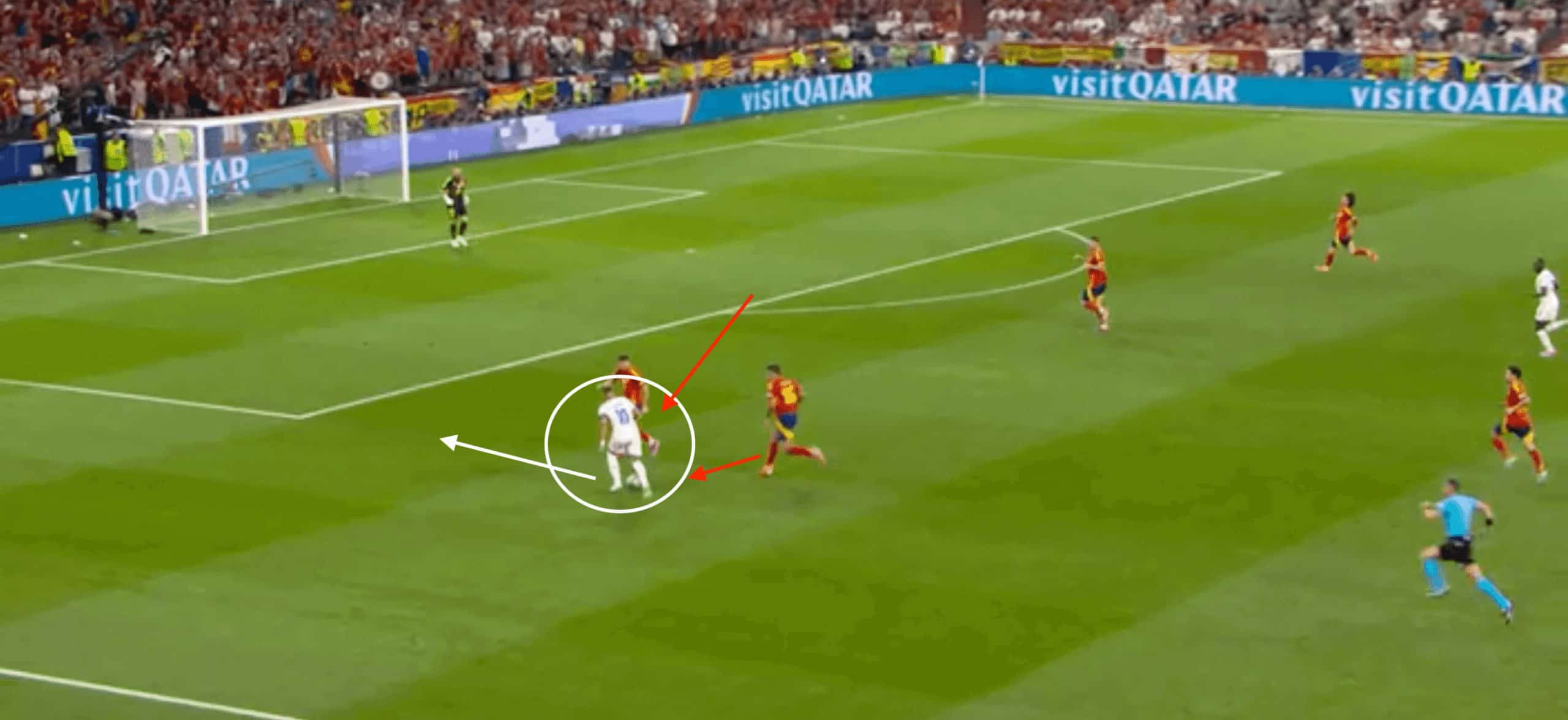
Spanish resilience and attacking creativity
Spain had previously only been behind on one occasion in this tournament, but the thought of overcoming a resilient French defence was arguably their toughest test yet. Instead of questioning their overall gameplan, it was refreshing to see De la Fuente press on with Spain’s attacking intent, providing both Navas and Cucurella with the freedom to be effective in the half spaces and when overlapping both Williams and Yamal. Perhaps Deschamps’ conservative pressing style spurred Spain on, with their main progressors afforded time on the ball to generate dangerous attacking sequences.
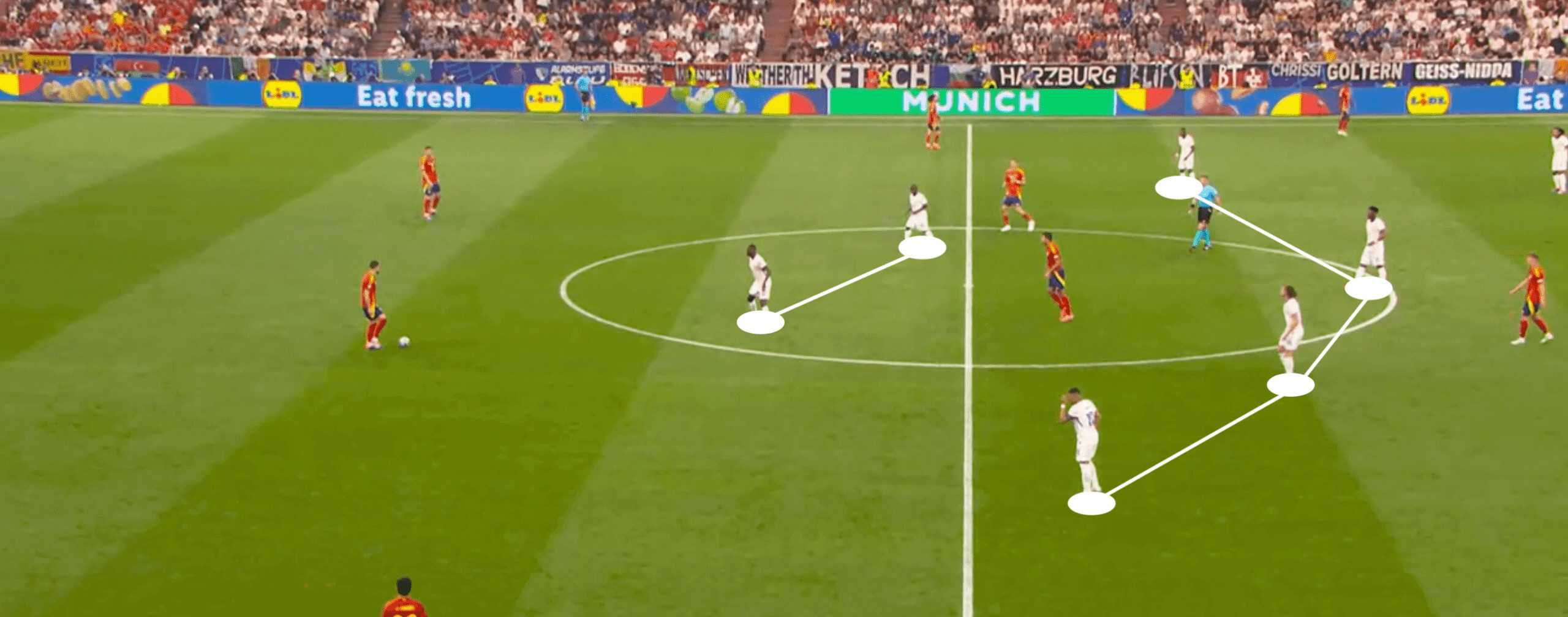
France utilised a 4-4-2 pressing style, with N’Golo Kante advancing to join Kolo Muani in pressing the two Spanish central defenders or even Rodri at times. This left Mbappé and Dembele to press Spain’s full-backs, who enjoy remaining deep and wide in the initial phase, to bait their opposition into stepping forward. For all the benefits that Mbappé provides when France is attacking, his defensive efforts create more problems for his team to mitigate, he is often seen to be sucked further inside the pitch by Nacho.
This created a dangerous issue in which Navas could occupy Hernández in an incredibly advanced position on the right wing, therefore allowing Yamal to create a midfield overload when drifting inside. It was from this position that Yamal was able to score an outrageous equalising goal, curling the ball past Maignan to become the youngest-ever goalscorer in the history of the European Championships- but most importantly, igniting the belief that Spain could dominate and press on for the winner.
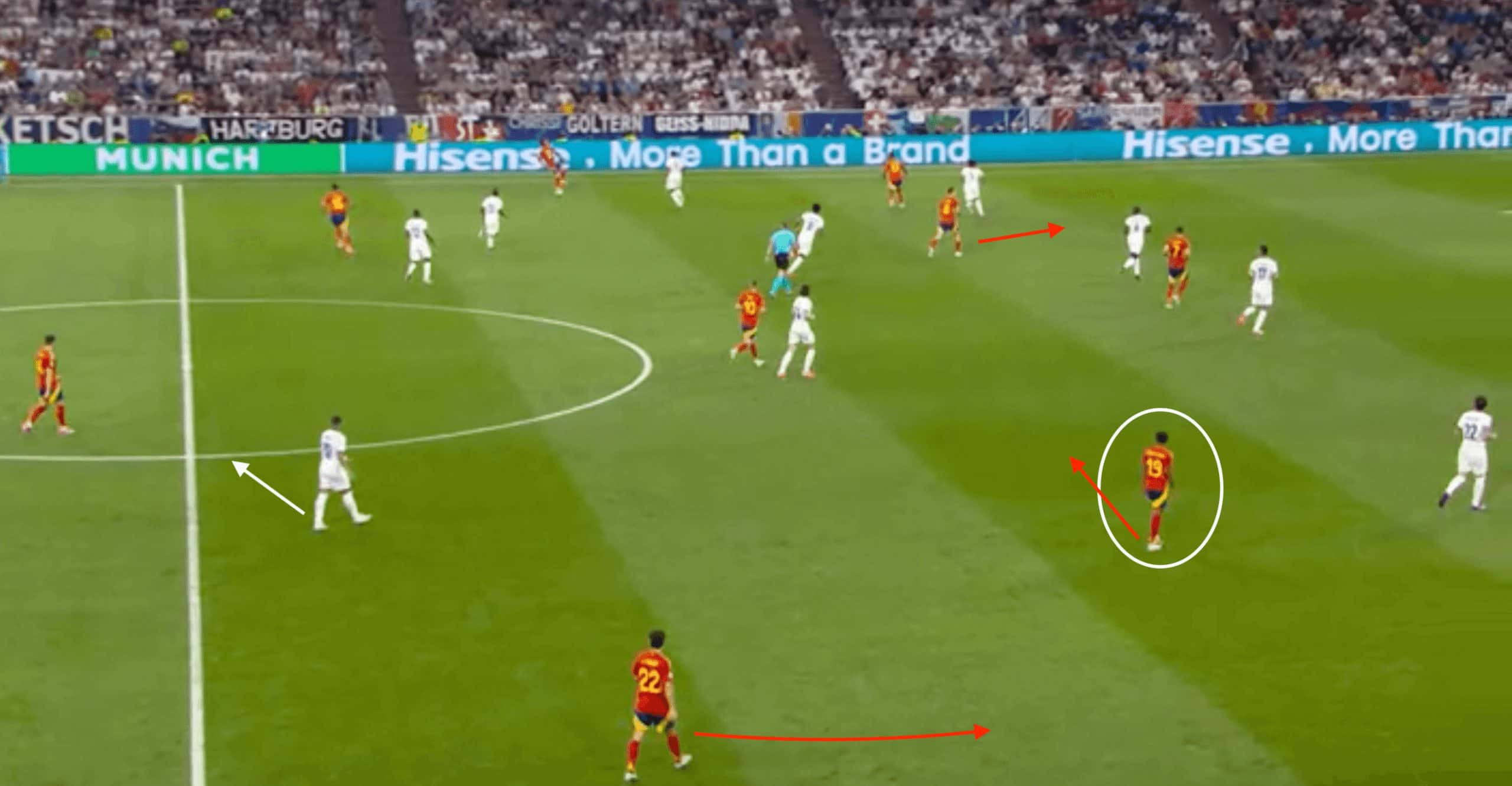
When looking at the overall picture of the match, Spain had concentrated 59% of their attacking touches down the left-hand side of the pitch, utilising the triangles formed by the inward movement of Nico Williams, with Fabian Ruiz dropping deeper towards Laporte to collect the ball. Marc Cucurella remaining a critical threat when breaking into the final third close to the touchline.
However, it was once again the right flank that conjured up the match-winning chance, with Spain often affording the necessary space due to Spain’s ability to switch flanks in an instant. Navas’ cross was deflected into space by Saliba, with Dani Olmo ready to pounce and strike towards goal past the bewildered Maignan, completing their rapid resurgence.
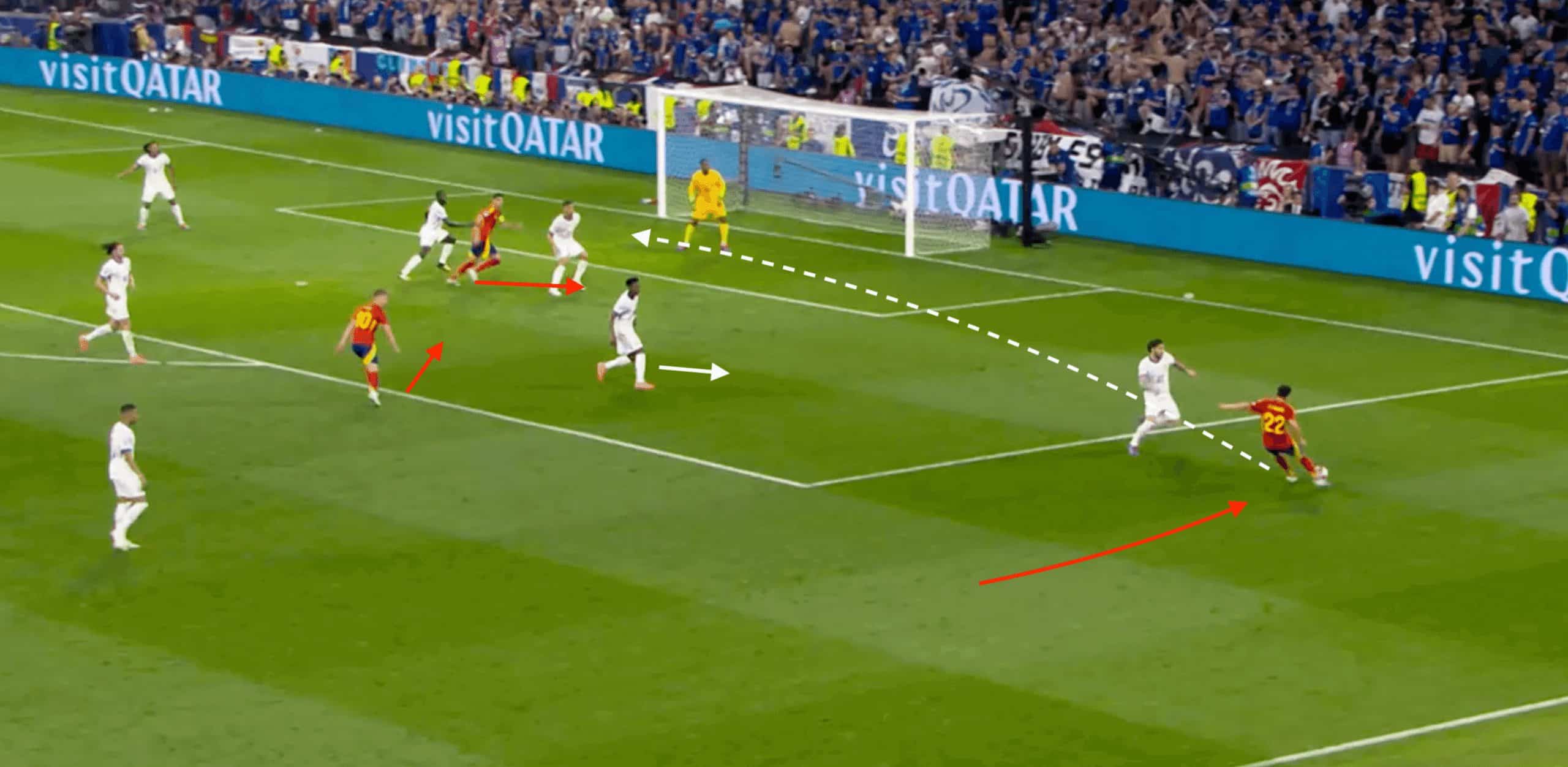
No way forward for France
One of the most important aspects of the semi-final was the two incredibly contrasting styles when out of possession, with Deschamps’ laboured press allowing Spain to flourish with easier passes into the final third. But most important of all was the Spanish reaction to going into the lead, undeterred by the game state, and negating the majority of French attacks with their suffocating press.
Spain elected to set up and match the French in their 4-4-2 pressing approach, but it was their individual commitment to cover ground which put them a step ahead of their opposition. Olmo joined Morata in applying pressure to the two French central defenders, whilst Fabián Ruiz shadowed the movement of Tchouaméni as he looked to drop deeper and offer himself as an early passing outlet. It was decisions like this which aimed to stifle any French progression from the outset, especially when Morata would press Maignan and force the goalkeeper to rush his distribution.
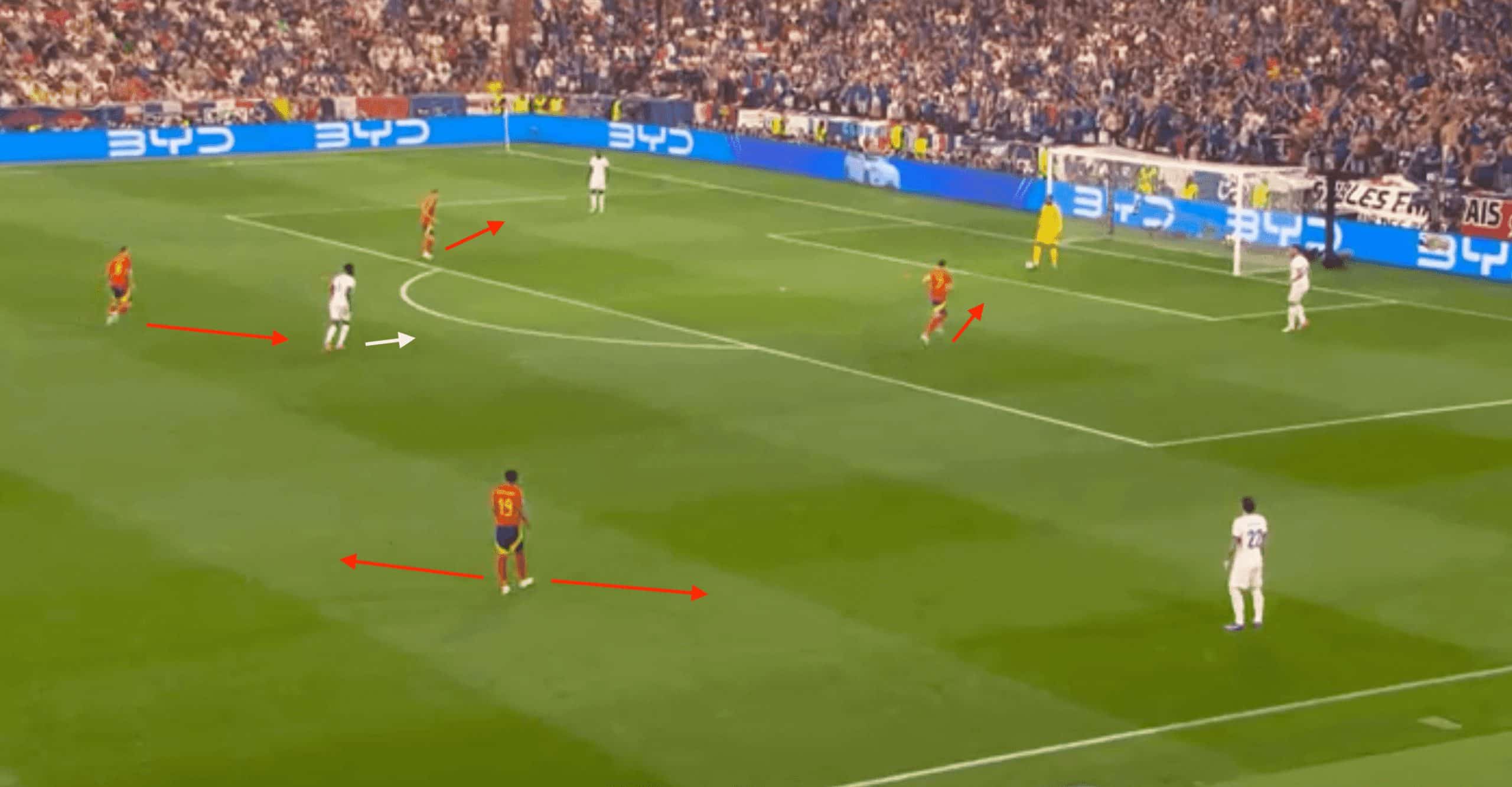
This, in theory, allowed both Rabiot and Kanté to double up on the isolated Rodri and exploit the room within the two half-spaces. However, with Rodri’s elevated defensive capabilities on display, the Manchester City midfielder was able to alleviate this threat as a result of his mobility, used to break up play quickly. Also, for France, it would seem like their midfield profiles were too conservative when looking to hurt Spain, where they had a numerical deficiency, with both Kanté and Rabiot lacking the technical prowess to link the midfield and attack in the absence of an elite creator between the lines.
Spain’s press was strengthened by the positioning of their two wingers, with both Williams and Yamal providing key defensive contributions, unlike the indolent Mbappé. De la Fuente had intelligently placed the two in an advantageous position between the French full-backs and advanced central midfielders. It meant that they could quickly press tight to Koundé and Hernández if France distributed the ball towards the flanks whilst also offering support inside the pitch should France capitalise on their midfield overload.
Spain offered an incredibly mature performance throughout the second half, taking advantage of their time on the ball and passing France off the park. The French tried to inject life into their attacking efforts, with Barcola offering a more direct playmaking role and Giroud providing a more natural striking presence within the Spanish penalty area. But such efforts were fruitless, as Spain held their lead and withstood the French barrage late in the game.
Conclusion
Looking towards Sunday, Spain will face an England side who have yet to reach the peak of their powers en route to the final. But for Spain, they remain in a favourable position- and for excellent reason! De la Fuente’s side boasts an excellent combination of attacking individualism and willingness to overcome adversity through their inspiring teamwork. Whilst they remain favourites heading into the match, Spain will feel as though they can continue to play with relative freedom considering the length of time this group have spent together, with preconceived notions never expecting Spain to be this dominant.





Comments